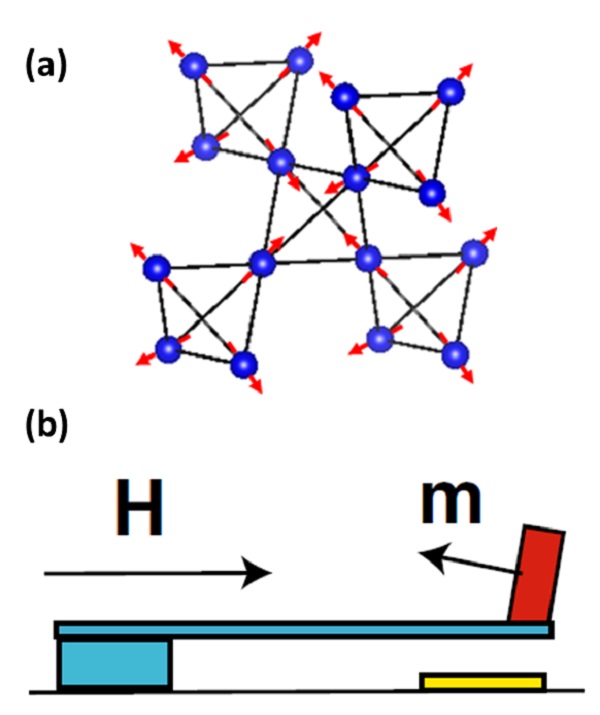Newly discovered response of magnets to magnetic field Scientists observe tiny orthogonal magnetization that changes metal into insulator


(a) All-in all-out (all-out all-in) structure created by iridium atoms on pyrochlore lattice; (b) schematic rendering of torque magnetometry
All iridium spins on the pyrochlore lattice point either toward (all-in) or away from (all-out) the center of the tetrahedron when causing metal-insulator transition. Orthogonal magnetization is detected by measuring torque magnetism.
© 2017 Tian Liang.
An international group consisting of University of Tokyo researchers and their collaborators detected a trace amount of magnetization—the phenomenon of assuming magnet-like properties—appearing perpendicular to a magnetic field applied to a substance that exhibits magnetic properties when a magnetic field is applied to it. This tiny perpendicular, or orthogonal, magnetization is instrumental in initiating the transition of metal into insulator, and carries the potential for use in such applications as magnetic memory and magnetic sensors.
It has long been known that magnets are magnetized along the magnetic field applied to them. However, magnetization perpendicular to the field is also expected according to thermodynamic theory. This orthogonal magnetization is so tiny that no study so far had been able to detect it experimentally.
The research group led by Professor Satoru Nakatsuji at the University of Tokyo’s Institute for Solid State Physics noticed slight changes in magnetization in the pyrochlore iridate Eu2Ir2O7—composed of europium (Eu), iridium (Ir), and oxygen (O)—following metal-insulator transition. Usually, only the magnetic component parallel to the field is detected when measuring magnetization; the researchers thus attempted to detect magnetization perpendicular to the field by measuring the torque magnetometry, or force producing the tendency of magnets to rotate in a magnetic field, by cantilever and found that orthogonal magnetization abruptly increases below the metal-insulator transition temperature. The group determined that orthogonal magnetization derives from the special spatial distribution of the magnetic charge (magnetic octupole), and that this is the origin (order parameter) of the metal-insulator transition.
"Thus far, magnets (ferromagnetic material) have been used in memory and other applications; pyrochlore iridate has been attracting much attention in recent years as it shares similar properties as a magnet, even though it is not a magnet," says Nakatsuji. He continues, "Our work reveals how to control the transport properties in this system. I hope that studying the switching mechanism and electric generation of non-magnet materials will lead to the development of high-density nonvolatile memory utilizing the small leakage magnetic field or new materials for thermoelectric generators and other devices."
The current study was conducted in collaboration with Princeton University and the Massachusetts Institute of Technology in the U.S. It was supported by JSPS KAKENHI Grant Number 15H05883 (J-Physics) and the Strategic Basic Research Programs (CREST) of the Japan Science and Technology Agency (JST) as a project covering "From understanding of topological electronic structure toward development of basic technology for energy harvesting" in the research area "Scientific Innovation for Energy Harvesting Technology."
Paper
, "Orthogonal magnetization and symmetry breaking in pyrochlore iridate Eu2Ir2O7", Nature Physics Online Edition: 2017/02/28 (Japan time), doi: 10.1038/nphys4051.
Article link (Publication)
Links
Institute for Solid State Physics
Graduate School of Frontier Sciences
Department of Advanced Materials Science, Graduate School of Frontier Sciences






